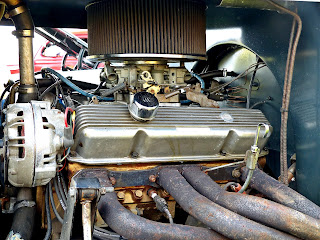 I was updating the Vintage V8 Photography website on Friday where I stated that the car show / drag racing season here in northern New England is drawing to a close. Columbus Day weekend is always a busy time, vintage vehicle wise, here in my neck of the woods. It's almost like the last weekend before Christmas and you gotta get all this stuff done before it's too late. I took Friday off from my regular job to take all this go-fast goodness in stride. So far, it's been three car shows as well as an end-of-the-season drag racing bash. The weather has been absolutely spectacular, and just a tad cool, which was a huge plus especially when it comes to quarter (or eighth) mile action. As I look back over the past 50 years, what is it about drag racing that still holds so much appeal? Even if it's just for myself? How 'bout you? You feel the same way?
I was updating the Vintage V8 Photography website on Friday where I stated that the car show / drag racing season here in northern New England is drawing to a close. Columbus Day weekend is always a busy time, vintage vehicle wise, here in my neck of the woods. It's almost like the last weekend before Christmas and you gotta get all this stuff done before it's too late. I took Friday off from my regular job to take all this go-fast goodness in stride. So far, it's been three car shows as well as an end-of-the-season drag racing bash. The weather has been absolutely spectacular, and just a tad cool, which was a huge plus especially when it comes to quarter (or eighth) mile action. As I look back over the past 50 years, what is it about drag racing that still holds so much appeal? Even if it's just for myself? How 'bout you? You feel the same way?I can vividly remember watching NHRA and AHRA sanctioned action on TV back in the late 60's. I preferred the AHRA coverage, even though it was less commonly covered on the tube, because the AHRA was a more flexible and liberal organization especially when it came to A/FX, Gassers, and other crazy shit that was coming down the pike. At that time, it was the closest I could get to the track and it would remain that way until I was in high school when I attended my first event at New England Dragway in Epping New Hampshire in the late 70's. Fortunately, there was still a mix of old and new back then. However, through the years, the nostalgia aspect was never really thought about until two events happened; 1). Older racers located in the mid-western United States started racing their vintage vehicles again and 2). 1960's muscle cars reached their first wave zenith in popularity (and price) the very late 80's. Even with this resurgence, vintage quarter mile cars were divided into two groups - the group that raced their cars, dollar value be damned, or the group that owned rare vintage race cars, but rarely exercised them due to their monetary value. It was only occasionally at national events, that these trailer queen vintage super stock, Gasser, A/FX, and funny cars would, for a brief moment, fill everyone's collective memories with the smell of nitro, racing fuel, and burnt rubber, along with the beautiful sound of open headers.
 It wasn't until the turn of the century when the old car hobby was truly diversifying, with genre's like rat rods, radical street cars, and barn finds, that nostalgia racing finally came back into it's own. Don't get me wrong - I'm not knocking the current NHRA racing, although I must admit it has to get it's act in gear if it's going to survive. Television coverage is down, as is event attendance,. but that's another kettle of fish I'm not going to cook. However, events like The Race Of Gentlemen, Goodguys, and other local and regional events too numerous to mention, have attracted a great deal of ink due to their uncomplicated racing template, rules, as well as making the entire event family friendly.
It wasn't until the turn of the century when the old car hobby was truly diversifying, with genre's like rat rods, radical street cars, and barn finds, that nostalgia racing finally came back into it's own. Don't get me wrong - I'm not knocking the current NHRA racing, although I must admit it has to get it's act in gear if it's going to survive. Television coverage is down, as is event attendance,. but that's another kettle of fish I'm not going to cook. However, events like The Race Of Gentlemen, Goodguys, and other local and regional events too numerous to mention, have attracted a great deal of ink due to their uncomplicated racing template, rules, as well as making the entire event family friendly.Whatever the event, big or small, for me, it's still the memories burned into my brain from when I was young. The sights, sounds, and action; it still hasn't changed a bit. Did you also realize that drag racing is the only sport where you have just one shot at winning, usually within just a couple of seconds? There are no halves, periods, quarters, innings, rounds, frames, sets, or multiple laps. It's just two vehicles; one will win, the other will not and thus gets eliminated. The winner gets to race again. No mulligans, no do-overs, no restarts, no relief drivers. You'd better be on your A-game or you're done. Intense, but oh so cool.
Until next time, long live nostalgia.
Dave

















































